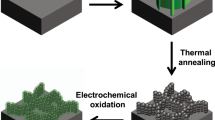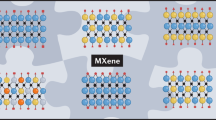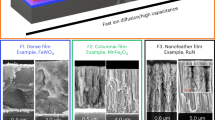Abstract
New materials hold the key to fundamental advances in energy conversion and storage, both of which are vital in order to meet the challenge of global warming and the finite nature of fossil fuels. Nanomaterials in particular offer unique properties or combinations of properties as electrodes and electrolytes in a range of energy devices. This review describes some recent developments in the discovery of nanoelectrolytes and nanoelectrodes for lithium batteries, fuel cells and supercapacitors. The advantages and disadvantages of the nanoscale in materials design for such devices are highlighted.
This is a preview of subscription content, access via your institution
Access options
Subscribe to this journal
Receive 12 print issues and online access
$259.00 per year
only $21.58 per issue
Buy this article
- Purchase on Springer Link
- Instant access to full article PDF
Prices may be subject to local taxes which are calculated during checkout








Similar content being viewed by others
References
Nazar, L. F. et al. Nanostructured materials for energy storage. Int. J. Inorg. Mater. 3, 191–200 (2001).
Hirshes, M. Nanoscale materials for energy storage. Mater. Sci. Eng. B 108, 1 (2004).
Scrosati, B. Challenge of portable power. Nature 373, 557–558 (1995).
Tarascon, J.-M. & Armand, M. Issues and challenges facing rechargeable batteries. Nature 414, 359–367 (2001).
Wakihara, W. & Yamamoto, O. (eds) Lithium Ion Batteries—Fundamentals and Performance (Kodansha-Wiley-VCH, Weinheim, 1998).
van Schalkwijk, W. & Scrosati, B. (eds) Advances in Lithium-Ion Batteries (Kluwer Academic/Plenum, New York, 2002).
Huggins, R. A. in Handbook of Battery Materials (ed. Besenhard, J. O.) Part III, Chapter 4 (Wiley-VCH, Weinheim, 1999).
Winter, M. & Besenhard, J. O. Electrochemical lithiation of tin and tin-based intermetallic and composites. Electrochim. Acta 45, 31–50 (1999).
Nazar, L. F. & Crosnier, O. In Lithium Batteries Science and Technology (eds Nazri,G.-A. & Pistoia, G.) 112–143 (Kluwer Academic/Plenum, Boston, 2004).
Idota, Y., Kabuto, T., Matsufuji, A., Maekawa, Y. & Miyasaki, T. Tin-based amorphous oxides: a high-capacity lithium-ion storage material. Science 276, 1395–1397 (1997).
Mao, O. & Dahn, J. R. Mechanically alloyed Sn–Fe(–C) powders as anode materials for Li ion batteries. III. Sn2Fe:SnFe3C active/inactive composites. J. Electrochem. Soc. 146, 423–427 (1999).
Beaulieu, L. Y. & Dahn, J. R. The reaction of lithium with Sn–Mn–C intermetallics prepared by mechanical alloying. J. Electrochem. Soc. 147, 3237–3241 (2000).
Graetz, J., Ahn, C. C., Yazami, R. & Fuetz, B. Highly reversible lithium storage in nanostructured silicon. Electrochem. Solid-State Lett. 6, A194–197 (2003).
Yang, J. et al. Si/C composites for high capacity lithium storage materials. Electrochem. Solid-State Lett. 6, A154–156 (2003).
Novak, P. et al. in Int. Meeting Li Batteries IMLB12 Nara, Japan Abstract 9 (2004).
Ikeda, H. et al. in Proc. 42nd Battery Symposium, Yokohama, Japan 282 (2001).
Green, M., Fielder, E., Scrosati, B., Wachtler, M. & Serra Moreno, J. Structured silicon anodes for lithium battery applications. Electrochem. Solid-State Lett. 6, A75–79 (2003).
Armstrong, A. R., Armstrong, G., Canales, Garcia, J. R. & Bruce, P. G. Lithium intercalation intoTiO2-B nanowires. Adv. Mater. (in the press).
Poizot, P., Laruelle, S., Grugeon, S., Dupont, L. & Tarascon, J.-M. Nano-sized transition metal oxides as negative electrode material for lithium-ion batteries. Nature 407, 496–499 (2000).
Tarascon, J.-M., Grugeon, S., Laruelle, S., Larcher, D. & Poizot, P. In Lithium Batteries Science and Technology (eds Nazri, G.-A. & Pistoia, G.) Ch. 7, 220–246 (Kluwer Academic/Plenum, Boston, 2004).
Denis, S., Baudrin, E., Touboul, M. & Tarascon, J.-M. Synthesis and electrochemical properties vs. Li of amorphous vanadates of general formula RVO4 (R = In, Cr, Fe, Al, Y) J. Electrochem. Soc. 144, 4099–4109 (1997).
Leroux, F., Coward, G. R., Power, W. P. & Nazar, L. F. Understanding the nature of low-potential Li uptake into high volumetric capacity molybedenum oxides. Electrochem Solid-State Lett. 1, 255–258 (1998).
Balaya, P., Li, H., Kienle, L. & Maier, J. Fully reversible homogeneous Li storage in RuO2 with high capacity. Adv. Funct. Mater. 13, 621–625 (2003).
Badway, F., Cosandey, F., Pereira, N. & Amatucci, G. G. Carbon metal fluoride nanocomposites: high capacity reversible metal fluoride conversion materials as rechargeable positive electrodes for Li batteries. J. Electrochem. Soc. 150, A1318–1327 (2003).
Li, H., Ritcher, G. & Maier, J. Reversibile formation and decomposition of LiF clusters using transition metal fluorides as precursors and their application in rechargeable Li batteries. Adv. Mater. 15, 736–739 (2003).
Jamnik, J., & Maier, J. Nanocrystallinity effects in lithium battery materials. Aspects of nano-ionics. Part IV. Phys. Chem. Chem. Phys. 5, 5215–5220 (2003).
Larcher, D. et al. Effect of particle size on lithium intercalation into α-Fe2O3 . J. Electrochem. Soc. 150, A133–139 (2003).
Sides, C. R., Li, N. C., Patrissi, C. J., Scrosati, B. & Martin, C. R. Nanoscale materials for lithium-ion batteries. Mater. Res. Bull. 27, 604–607 (2002).
Nordliner, S., Edström, K. & Gustafsson, T. Electrochemistry of vanadium oxide nanotubes. Electrochem. Solid State Lett. 4, A129 (2001).
Le, D. B. et al. High surface area V2O5 aerogel intercalation electrodes. J. Electrochem. Soc. 143, 2099–2104 (1996).
Dong, W., Rolison, D. R. & Dunn, B. Electrochemical properties of high surface area vanadium oxides aerogels. Electrochem. Solid State Lett. 3, 457–459 (2000).
Thackeray, M. M., David, W. I. F., Bruce, P. G. & Goodenough, J. B. Lithium insertion into manganese spinels. Mater. Res. Bull. 18, 461–472 (1983).
Robertson, A. D., Armstrong, A. R. & Bruce, P. G. Layered LixMnyCo1–yO2 intercalation electrodes: influence of ion exchange on capacity and structure upon cycling. Chem. Mater. 13, 2380–2386 (2001).
Shao-Horn, Y. et al. Structural characterisation of layered LiMnO2 electrodes by electron diffraction and lattice imaging. J. Electrochem. Soc. 146, 2404–2412 (1999).
Wang, H. F., Jang, Y. I. & Chiang, Y.-M. Origin of cycling stability in monoclinic and orthorhombic-phase lithium manganese oxide cathodes. Electrochem. Solid-State Lett. 2, 490–493 (1999).
Kang, S. H., Goodenough, J. B. & Rabenberg, L. K. Effect of ball-milling on 3 V capacity of lithium manganese oxospinel cathodes. Chem. Mater. 13, 1758–1764 (2001).
Reed, J., Ceder, G. & van der Ven, A. Layered-to-spinel phase transformation in LixMnO2 . Electrochem. Solid-State Lett. 4, A78–81 (2001).
Padhi, A. K., Nanjundaswamy, K. S., Masquelier, C., Okada, S. & Goodenough, J. B. Effect of structure on the Fe3+/Fe2+redox couple in iron phosphates. J. Electrochem. Soc. 144, 1609–1613 (1997).
Ravet, A. et al. Electroactivity of natural and synthetic triphylite. J. Power Sources 97–98, 503–507 (2001).
Huang, H., Yin, S.-C. & Nazar, L. F. Approaching theoretical capacity of LiFePO4 at room temperature and high rates. Electrochem. Solid-State Lett. 4, A170–172 (2001).
Croce, F., Scrosati, B., Sides, B. R. & Martin, C. R. in 206th Meeting Electrochemical Society, Honolulu, Hawaii Abstract 241 (2004).
Scrosati, B. & Vincent, C. A. Polymer electrolytes: the key to lithium polymer batteries. Mater. Res. Soc. Bull. 25, 28–30 (2000).
Croce, F., Appetecchi, G. B., Persi, L. & Scrosati, B. Nanocomposite polymer electrolytes for lithium batteries. Nature 394, 456–458 (1998).
MacFarlane, D. R., Newman, P. J., Nairn, K. M. & Forsyth, M. Lithium-ion conducting ceramic/polyether composites. Electrochim. Acta 43, 1333–1337 (1998).
Kumar, B., Rodrigues, S. J. & Scanlon, L. Ionic conductivity of polymer–ceramic composites. J. Electrochem. Soc. 148, A1191–1195 (2001).
Maier, J. Ionic conduction in space charge regions. Prog. Solid State Chem. 23, 171–263 (1995).
Appetecchi, G. B., Croce, F., Persi, L., Ronci, F. & Scrosati, B. Transport and interfacial properties of composite polymer electrolytes. Electrochim. Acta 45, 1481–1490 (2000).
Angell, C. A., Liu, C. & Sanchez, S. Rubbery solid electrolytes with dominant cationic transport and high ambient conductivity. Nature 362, 137–139 (1993).
Hawett, P. C., MacFarlane, D. R. & Hollenkamp, A. F. High lithium metal cycling efficiency in a room-temperature ionic liquid. Electrochem. Solid-State Lett. 7, A97–101 (2004).
MacGlashan, G., Andreev, Y. G. &. Bruce, P. G. The structure of poly(ethylene oxide)6:LiAsF6 . Nature 398, 792–794 (1999).
Gadjourova, Z., Andreev, Y. G., Tunstall, D. P. & Bruce, P. G. Ionic conductivity in crystalline polymer electrolytes. Nature 412, 520–523 (2001).
Stoeva, Z., Martin-Litas, I., Staunton, E., Andreev Y. G. & Bruce, P. G. Ionic conductivity in the crystalline polymer electrolytes PEO6:LiXF6, X = P, As, Sb. J. Am. Chem. Soc. 125, 4619–2626 (2003).
Christie, A. M., Lilley, S. J., Staunton, E., Andreev, Y. G. & Bruce, P. G. Increasing the conductivity of crystalline polymer electrolytes. Nature 433, 50–53 (2005).
Conway, B. E. Electrochemical Supercapacitors. (Kluwer Academic/Plenum, New York, 1999).
Mastragostino, M., Arbizzani, C. & Soavi, F. In Advances in Lithium-Ion Batteries. (Van Schalkwijk, W. & Scrosati, B., eds) Ch. 16, 481–505 (Kluwer Academic/Plenum, New York, 2002).
Arbizzani, C., Mastragostino, M. & Soavi, S. New trends in electrochemical supercapacitors. J. Power Sources 100, 164–170 (2001).
Wang, J. et al. Morphological effects on the electrical and electrochemical properties of carbon aerogels. J. Electrochem. Soc. 148, D75–77 (2001).
Niu, C., Sichjel, E. K., Hoch, R., Hoi, D. & Tennent, H. High power electrochemical capacitors based on carbon nanotube electrodes. Appl. Phys. Lett. 70, 1480–1482 (1997).
Nelson, P. A. & Owen, J. R. A high-performance supercapacitor/battery hybrid incorporating templated mesoporous electrodes. J. Electrochem. Soc. 150, A1313–1317 (2003).
Amatucci, G. G., Badway, F., Du Pasquier, A. & Zheng, T. An asymmetric hybrid nonaqueous energy storage cell. J. Electrochem. Soc. 148, A930–939 (2001).
Brodd, R. J. et al. Batteries 1977 to 2002. J. Electrochem. Soc. 151, K1–11 (2004).
Srinivasan, S., Mosdale, R., Stevens, P. & Yang, C. Fuel cells: reaching the era of clean and efficient power generation in the twenty-first century. Annu. Rev. Energy Environ. 24, 281–238 (1999).
Giordano, N. et al. Analysis of platinum particle size and oxygen reduction in phosphoric acid. Electrochim. Acta 36, 1979–1984 (1991).
Freund, A., Lang, J., Lehman, T. & Starz, K. A. Improved Pt alloy catalysts for fuel cells. Catal. Today 27, 279–283 (1996).
Mukerjee, S., Srinivasan, S., Soriaga, M. P. & McBreen, J. Role of structural and electronic properties of Pt and Pt alloys on electrocatalysis of oxygen reduction. An in-situ XANES and EXAFS investigation. J. Electrochem. Soc. 142, 1409–1422 (1995).
Aricò, A. S., Srinivasan, S. & Antonucci, V. DMFCs: From fundamental aspects to technology development. Fuel Cells 1, 133–161 (2001).
Schmidt, T. J. et al. Electrocatalytic activity of Pt–Ru alloy colloids for CO and CO/H2 electrooxidation: stripping voltammetry and rotating-disk measurements. Langmuir 14, 2591–2595 (1997).
Chrzanowski, W. & Wieckowski, A. Enhancement in methanol oxidation by spontaneously deposited ruthenium on low-index platinum-electrodes. Catal. Lett. 50, 69–75 (1998).
Brankovic, S. R., Wang, J. X. & Adzic, R. R. Pt submonolayers on Ru nanoparticles–a novel low Pt loading, high CO tolerance fuel-cell electrocatalyst. Electrochem. Solid-State Lett. 4, A217–220 (2001).
Hockaday, R. G. et al. in Proc. Fuel Cell Seminar, Portland, Oregon, USA 791–794 (Courtesy Associates, Washington DC, 2000).
Sun, G. R., Wang, J. T. & Savinell, R. F. Iron(III) tetramethoxyphenylporphyrin (Fetmpp) as methanol tolerant electrocatalyst for oxygen reduction in direct methanol fuel-cells. J. Appl. Electrochem. 28, 1087–1093 (1998).
Reeve, R. W., Christensen, P. A., Hamnett, A., Haydock, S. A. & Roy, S. C. Methanol tolerant oxygen reduction catalysts based on transition metal sulfides. J. Electrochem. Soc. 145, 3463–3471 (1998).
Nolte, R., Ledjeff, K., Bauer, M. & Mulhaupt, R. Partially sulfonated poly(arylene ether sulfone)—a versatile proton conducting membrane material for modern energy conversion technologies. J. Membrane Sci. 83, 211–220 (1993).
Kerres, J., Ullrich, A., Meier, F. & Haring, T. Synthesis and characterization of novel acid-base polymer blends for application in membrane fuel cells. Solid State Ionics 125, 243–249 (1999).
Alberti, G. & Casciola, M. Composite membranes for medium-temperature PEM fuel cells. Annu. Rev. Mater. Res. 33, 129–154 (2003).
Savadogo, O. Emerging membranes for electrochemical systems: (I) solid polymer electrolyte membranes for fuel cell systems. J. New Mater. Electrochem. Syst. 1, 47–66 (1998).
Li, Q., He, R., Jensen, J. O. & Bjerrum, N. J. Approaches and recent development of polymer electrolyte membranes for fuel cells operating above 100 °C. Chem. Mater. 15, 4896–4815 (2003).
Kreuer, K. D. On the development of proton conducting polymer membranes for hydrogen and methanol fuel cells. J. Membrane Sci. 185, 29–39 (2001).
Watanabe, M., Uchida, H., Seki, Y., Emori, M. & Stonehart, P. Self-humidifying polymer electrolyte membranes for fuel cells. J. Electrochem. Soc. 143, 3847–3852 (1996).
Aricò, A. S., Creti, P., Antonucci, P. L. & Antonucci, V. Comparison of ethanol and methanol oxidation in a liquid feed solid polymer electrolyte fuel cells at high temperature. Electrochem. Solid-State Lett. 1, 66–68 (1998).
Aricò, A. S., Baglio, V., Di Blasi, A. & Antonucci, V. FTIR spectroscopic investigation of inorganic fillers for composite DMFC membranes. Electrochem. Commun. 5, 862–866 (2003).
Kreuer, K. D., Paddison, S. J., Spohr, E. & Schuster, M. Transport in proton conductors for fuel cell applications: simulation, elementary reactions and phenomenology. 104, 4637–4678 (2004).
Kreuer, K. D. On the development of proton conducting materials for technological applications. Solid State Ionics 97, 1–15 (1997).
Debe, M. K. Handbook of Fuel Cells—Fundamentals, Technology and Applications Vol. 3 (eds Vielstich, W., Gasteiger, H. A. & Lamm, A.) Ch. 45, 576–589 (Wiley, Chichester, UK, 2003).
Atanasoski, R. in 4th Int. Conf. Applications of Conducting Polymers, ICCP-4, Como, Italy Abstract 22 (2004).
Schoonman, J. Nanoionics. Solid State Ionics 157, 319–326 (2003).
Steele, B. C. H. Current status of intermediate temperature fuel cells (It-SOFCs). European Fuel Cell News 7, 16–19 (2000).
Maier, J. Defect chemistry and ion transport in nanostructured materials. Part II Aspects of nanoionics. Solid State Ionics 157, 327–334 (2003).
Knauth, P. & Tuller, H. L. Solid-state ionics: roots, status, and future-prospects. J. Am. Ceram. Soc. 85, 1654–1680 (2002).
Perry Murray, E., Tsai, T. & Barnett, S. A. A direct-methane fuel cell with a ceria-based anode. Nature 400, 649–651 (1999).
Park, S., Vohs, J. M. & Gorte, R. J. Direct oxidation of hydrocarbons in a solid-oxide fuel cell. Nature 404, 265–267 (2000).
Zhou, Y. P., Feng, K., Sun, Y. & Zhou, L. A brief review on the study of hydrogen storage in terms of carbon nanotubes. Prog. Chem. 15, 345–350 (2003).
Schlappach, L. & Zuttel, A. Hydrogen-storage materials for mobile applications. Nature 414, 353–358 (2001).
Dillon, A. C. et al. Storage of hydrogen in single-walled carbon nanotubes. Nature 386, 377–379 (1997).
Chambers, A., Park, C., Baker, R. T. K. & Rodriguez, N. M. Hydrogen storage in graphite nanofibers. J. Phys. Chem. 102, 4253–4256 (1998).
Yang, R. T. Hydrogen storage by alkali-doped carbon nanotubes—revisited. Carbon 38, 623–626 (2000).
Dillon, A. C. & Heben, M. J. Hydrogen Storage using carbon adsorbents—past, present and future. Appl. Phys. A 72, 133–142 (2001).
Hirscher, M. & Becher, M. Hydrogen storage in carbon nanotubes. J. Nanosci. Nanotechnol. 3, 3–17 (2003).
Shang, C. X., Bououdina, M., Song, Y. & Guo, Z. X. Mechanical alloying and electronic simulation of MgH2–M systems (M–Al, Ti, Fe, Ni, Cu, and Nb) for hydrogen storage. Int. J. Hydrogen Energy 29, 73–80 (2004).
Bobet, J. L., Grigorova, E., Khrussanova, M., Khristov, M. & Peshev, P. Hydrogen sorption properties of the nanocomposite 90wt.% Mg2Ni–10 wt.% V. J. Alloys Compounds 356, 593–597 (2003).
Ma, R. Z. et al. Synthesis of boron-nitride nanofibers and measurement of their hydrogen uptake capacity. Appl. Phys. Lett. 81, 5225–5227 (2002).
Bobet, J. L., Desmoulinskrawiec, S., Grigorova, E., Cansell, F. & Chevalier, B. Addition of nanosized Cr2O3 to magnesium for improvement of the hydrogen sorption properties. J. Alloys Compounds 351, 217–221 (2003).
Audemer, A., Wurm, C., Morcrette, M., Gwizdala, S. & Masquellier, C. Carbon-coated metal bearing powders and process for production thereof. World Patent WO 04/001881 A2 (2004).
Acknowledgements
We thank M. Mastragostino of the university of Bologna for suggestions and help in completing the supercapacitors part of this review. Support from the European Network of Excellence 'ALISTORE' network is acknowledged. P.G.B. is indebted to the Royal Society for financial support.
Author information
Authors and Affiliations
Corresponding author
Ethics declarations
Competing interests
The authors declare no competing financial interests.
Rights and permissions
About this article
Cite this article
Aricò, A., Bruce, P., Scrosati, B. et al. Nanostructured materials for advanced energy conversion and storage devices. Nature Mater 4, 366–377 (2005). https://doi.org/10.1038/nmat1368
Issue Date:
DOI: https://doi.org/10.1038/nmat1368
This article is cited by
-
Fabrication, structural, and enhanced mechanical behavior of MgO substituted PMMA composites for dental applications
Scientific Reports (2024)
-
Vertical iontronic energy storage based on osmotic effects and electrode redox reactions
Nature Energy (2024)
-
Kinetics of the photocatalytic degradation of methylene blue under natural sunlight irradiation using nanocatalysts Ce3+ and Mg2+ co-doped CaFeO3−δ
Reaction Kinetics, Mechanisms and Catalysis (2024)
-
The study of structural, electrochemical and optical properties of Li2ZrN2 cathode material for Li-ion battery: an Ab-initio calculations
Journal of Solid State Electrochemistry (2024)
-
Tin (Sn)-doped hematite (α-SnxFe2-xO3) nanostructures as high-performance electrodes for supercapacitor application
Journal of Solid State Electrochemistry (2024)



